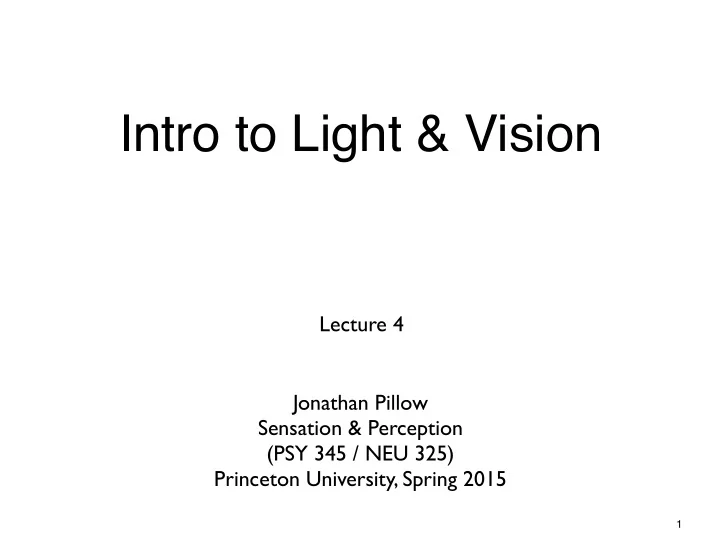

Intro to Light & Vision Lecture 4 Jonathan Pillow Sensation & Perception (PSY 345 / NEU 325) Princeton University, Spring 2015 1
(Chapter 1 leftovers) 2
Figure 1.16 Detecting a stimulus using the signal detection theory (SDT) approach (Part 2) 3
d-prime - measure of sensitivity 4
Figure 1.18 For a fixed d ʹ″ , all you can do is change the pattern of your errors by shifting the response criterion 5
Signal Detection Theory Terms to know: “noise” distribution : values arising when stimulus not present “signal” distribution : values arising when signal + noise present Type I error : rate of “false alarms”, or false positives Type II error : rate of “misses”, or false negatives psychometric function : describes probability of saying “I heard it” as function of stimulus intensity 6
Summary • Weber-Fechner law • Stevens’ power law • psychophysics • psychometric function • signal detection theory: threshold, criterion, Hit/ Miss, FA/CR, d’ = d-prime • brain regions, spikes, synapses, neurotransmitter 7
Chapter 2: First steps in Vision 8
Light : electromagnetic radiation within a narrow energy range • a wave: can be bent by lenses • a particle: “photons” - can travel through a vacuum, have minimum energy that can be emitted/absorbed (quanta) • Light: A wave; a stream of photons, tiny particles that each consist of one quantum of energy 9
Food for thought : Why are we sensitive to such a narrow range of the electromagnetic spectrum? 10
Food for thought : Why are we sensitive to such a narrow range of the electromagnetic spectrum? Other solutions are possible: • bees: ultraviolet light • pit vipers: infrared light 10
Light Physics What it all looks like. (Messy!) • each point in space has light from all angles passing through it 11
Why do we need optics? • without optics, light from object screen everything hits the whole retina/screen/film • with optics, we form an pinhole camera image • i.e. light from a single point image in space hits a single spot on the retina 12
Pinhole camera: problem of pinhole size smaller aperture = fewer rays = sharper image = dimmer image 13
Some pinhole images why? big pinhole small pinhole tiny pinhole 14
diffraction • bending of waves around small obstacles or through small apertures slit = 1 x wavelength slit = 5 x wavelength 15
diffraction • bending of waves around small obstacles or through small apertures slit = 1 x wavelength slit = 5 x wavelength 15
the eye (viewed from above) 16
• Cornea : The transparent “window” into the eyeball (carries 2/3 of eye’s total refractive power) • Aqueous humor : watery fluid in behind cornea • Lens : allows changing of focus • Pupil : The dark circular opening at the center of the iris in the eye, where light enters the eye • Vitreous humor : transparent fluid that fills main cavity of the eye (gel-like; may contain “floaters”) • Retina : light-sensitive membrane in the back of the eye that contains rods and cones. 17
• photic sneeze reflex tendency to sneeze when walking from a dark room into bright light topic of debate: • Aristotle - “sun heats the nose.” • Bacon - closed eyes and didn’t sneeze! • current thinking: “crossed wiring” 18
Image formation with a lens Goal is to focus the light rays emanating from a single point to a single point on the imaging surface 19
lenses converging diverging 20
Refraction: necessary to focus light rays, carried out by lens • Accommodation : process in which the lens changes its shape, altering its refractive power • Emmetropia : no refractive error 21
Figure 2.3 Optics of the human eye (near-sightedness) (far-sightedness) • too fat / powerful • too thin / not enough • eye is too long accommodation • eye is too short 22
normal eye - accomodation min max far away object Good near object Good (courtesy ben backus) 23
normal eye - accomodation min max far away object Good near object Good (courtesy ben backus) 24
myopic (near-sighted) eye • lens too powerful min max can’t get far far away objects in object focus near object Good 25
myopic (near-sighted) eye • lens too powerful min max can’t get far far away objects in object focus near object Good 26
hyperopic (farsighted) eye • lens not powerful enough min max far away object Good near object 27
hyperopic (farsighted) eye • lens not powerful enough min max far away object Good can’t get near near objects in object focus 28
• Astigmatism : visual defect caused by the unequal curving of one or more of the refractive surfaces of the eye, usually the cornea • if you have an astigmatism, some lines will have lower contrast 29
Camera analogy for the eye • Aperture (F-stop) = Iris/pupil . Regulates the amount of light coming into the eye • Focus = Lens . Changes shape to change focus • Film = Retina . Records the image 30
Summary • light, electromagnetic spectrum, visible spectrum • light as a wave / particle • pinhole cameras, lenses, image formation, blur, diffraction, optics of the eye • anatomy of the eye (cornea, pupil, iris, aqueous, cilliary muscle, lens, vitreous, fovea, retina, and who could forget the Zonules of Zinn!) • accommodation, emmetropia, refractive errors (hyperopia, myopia, astigmatism) 31
Recommend
More recommend